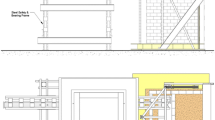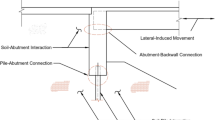Abstract
Many bridge abutments suffered severe damages due to pounding of superstructure elements of the bridge during seismic excitation. Collision of the girder is resisted by passive pressures mobilised in the backfill soils. Seismic load on the bridge structure causes the bridge abutments to undergo lateral translation (Δ) and rotation. The present study focuses on the evaluation of passive force (Pp) developed in the reinforced backfills of the geosynthetic-reinforced soil (GRS) bridge abutments. The GRS abutments of nine configurations with three different geogrid spacing and three different geogrid lengths are modelled using finite element (FE) approach under lateral push. Hypoplastic soil constitutive model with inter-granular strain concept is used to model the soil behaviour. User material subroutine, VUMAT is developed to simulate the soil behaviour in Abaqus. The maximum passive resistance (Pp,ult) increases by 12% in the GRS abutments with closer geogrid spacing.









Similar content being viewed by others
Abbreviations
- C u :
-
Uniformity coefficient
- d 50 :
-
Mean grain size (m)
- EX:
-
Experiment
- e c0 :
-
Maximum void ratio
- e d0 :
-
Minimum void ratio
- e i :
-
Initial void ratio
- e i0 :
-
Maximum possible void ratio at zero pressure and is equal to 1.1ec0
- h :
-
Height of the abutment wall (m)
- h s :
-
Granular hardness
- K 50 :
-
Average abutment stiffness (MN/m/m)
- L :
-
Length of the geogrid reinforcement (m)
- M w :
-
Moment magnitude
- n :
-
An exponent
- P a :
-
Active lateral thrust on the facing (kN/m)
- PGV:
-
Peak ground velocity
- P p :
-
Lateral passive force (kN/m)
- P p,ult :
-
Maximum passive resistance (kN/m)
- s :
-
Spacing of geogrid reinforcement (m)
- α :
-
An exponent
- γ :
-
Unit weight of soil (kN/m3)
- Δ :
-
Lateral displacement of the abutment wall (m)
- Δ 50 :
-
Lateral displacement of the abutment wall at Pp,ult/2 (m)
- Δ max :
-
Lateral displacement of the abutment wall at Pp,ult (m)
- ε a :
-
Axial strain
- σ c :
-
Triaxial cell pressure (kN/m2)
- σ d :
-
Deviatoric stress (kN/m2)
- σ h :
-
Lateral earth pressure (kN/m2)
- φ c :
-
Critical friction angle
References
Setyowulan D, Yamao T, Yamamoto K, Hamamoto T (2016) Investigation of seismic response on girder bridges: the effect of displacement restriction and wing wall types. Procedia—Soc Behav Sci 218:104–117
Kawashima K, Takahashi Y, Ge H, Wu Z, Zhang J (2009) Reconnaissance report on damage of bridges in 2008 Wenchuan, China, Earthquake. J Earthq Eng 13:965–996
Wieser JD, Maragakis E, Buckle IG, Zaghi AE (2012) Experimental evaluation of seismic pounding at seat type abutments of horizontally curved bridges, In: Proceedings of fifteenth world conference on earthquake engineering, Lisbon, pp 1–10
Malhotra PK, Huang MJ, Shakal AF (1995) Seismic interaction at separation joints of an instrumented concrete bridge. Earthq Eng Struct Dyn 24:1055–1067
Hao H, Bi K, Chouw N, Ren W (2013) State-of-the-art review on seismic induced pounding response of bridge structures. J Earthq Tsunami 7:1350019
Chouw N, Hao H, Su H (2006) Multi-sided pounding response of bridge structures with non-linear bearings to spatially varying ground excitation. Adv Struct Eng 9:55–66
AASHTO (2014) Guide specifications for LRFD seismic bridge design. American Association of State and Highway Transportation Officials, Washington, DC
Wu JTH, Lee KZZ, Pham T (2006) Allowable bearing pressure of bridge sills on GRS abutments with flexible facing. J Geotech Geoenviron Eng 132:836–841
Wu JTH, Lee KZZ, Helwany SB, Ketchart K (2006) Design and construction guidelines for GRS bridge abutment with a flexible facing. National Cooperative Highway Research Program, Washington, DC
Ketchart K, Wu JTH (1997) Loading test of GRS bridge pier and abutment in Denver, Colorado. Department of Transportation, Colorado
Zheng Y, Fox PJ (2016) Numerical investigation of geosynthetic-reinforced soil bridge abutments under static loading. J Geotech Geoenviron Eng 142:04016004
Zheng Y, Fox PJ (2017) Numerical investigation of the geosynthetic reinforced soil integrated bridge system under static loading. J Geotech Geoenviron Eng 143:04017008
Ardah A, Abu-Farsakh M, Voyiadjis G (2017) Numerical evaluation of the performance of a geosynthetic reinforced soil-integrated bridge system (GRS-IBS) under different loading conditions. Geotext Geomembr 45:558–569
Fredrickson (2015) Large-scale testing of passive force behavior for skewed bridge abutments with gravel and geosynthetic reinforced soil (GRS) Backfills. Dissertation, Brigham Young University, Utah
Fredrickson A, Rollins KM, Nicks J (2017) Passive force-deflection behaviour of geosynthetic-reinforced soil backfill based on large-scale tests. Geotechn Front 2017 GSP 278:23–32
Bozorgzadeh A (2007) Effect of structure backfill on stiffness and capacity of bridge abutments. Dissertation, University of California, San Diego
Lemnitzer A, Ahlberg ER, Nigbor RL, Shamsabadi A, Wallace JW, Stewart JP (2009) Lateral performance of full-scale bridge abutment wall with granular backfill. J Geotech Geoenviron Eng 135:506–514
Wilson PR (2009) Large scale passive force-displacement and dynamic earth pressure experiments and simulations. Dissertation, University of California, San Diego
Wilson P, Elgamal A (2010) Large-scale passive earth pressure load-displacement tests and numerical simulation. J Geotech Geoenviron Eng 136:1634–1643
Rollins KM, Jessee SJ (2013) Passive force-deflection plots for skewed abutments. J Bridge Eng 18:1086–1094
Duncan JM, Mokwa RL (2001) Passive earth pressures: theories and tests. J Geotech Geoenviron Eng 127:248–257
Shamsabadi A, Rollins KM, Kapuskar M (2007) Nonlinear soil-abutment-bridge structure interaction for seismic performance-based design. J Geotech Geoenviron Eng 133:707–720
Shamsabadi A, Khalili-Tehrani P, Stewart JP, Taciroglu E (2010) Validated simulation models for lateral response of bridge abutments with typical backfills. J Bridge Eng 15:302–311
Caltrans (2013) Seismic design criteria version 1.7. California Department of Transportation, Sacramento
Niemunis A, Herle I (1997) Hypoplastic model for cohesionless soils with elastic strain range. Mech Cohes Frict Mater 2:279–299
Bauer E, Wu W (1993) A hypoplastic model for granular soils under cyclic loading. In: Kolymbas D (ed) Modern approaches to plasticity. Elsevier, Amsterdam
von Wolffersdorff PA (1996) A hypoplastic relation for granular materials with a predefined limit state surface. Mech Cohes Frict Mater 1:251–271
Herle I, Gudehus G (1999) Determination of parameters of a hypoplastic constitutive model from properties of grain assemblies. Mech Cohes Frict Mater 4:461–486
Kolymbas D (2000) Introduction to hypoplasticity. AA Balkema, Rotterdam
Verdugo R, Ishihara K (1996) The steady state of sand soils. Soils Found 36:81–91
Stewart JP, Taciroglu E, Wallace JW, Ahlberg ER, Lemnitzer A, Rha C, Tehrani P, Keowen S, Nigbor RL, Salamanca A (2007) Full scale cyclic testing of foundation support systems for highway bridges—part II: abutment backwalls. University of California, Los Angeles
Ramalakshmi M (2018) Static, cyclic and seismic response analyses of GRS bridge abutments. Ph.D Thesis, Indian Institute of Technology, Madras
Jain SK, Lettis B, Murty CVR, Bardet J-P (2002) Bhuj, India earthquake of January 26, 2001. Supplement A to volume 18 of earthquake spectra. Earthquake Engineering Research Institute. Oakland, p 398
FHWA (2011) Postearthquake reconnaissance report on transportation infrastructure impact of the February 27, 2010, offshore maule earthquake in Chile. Federal Highway Administration, McLean, Virginia
Massumi A, Mohammadi R (2016) Structural redundancy of 3D RC frames under seismic excitations. Struct Eng Mech 59:15–36
Wu Y-M, Teng T-L, Shin T-C, Hsiao N-C (2003) Relationship between peak ground acceleration, peak ground velocity, and intensity in Taiwan. Bull Seismol Soc Am 93:386–396
Somerville PG, Smith NF, Graves RW, Abrahamson NA (1997) Modification of empirical strong ground motion attenuation relations to include the amplitude and duration effects of rupture directivity. Seismol Res Lett 68:199–222
Ling-kun C, Li-zhong J, Wei G, Wen-shuo L, Zhi-ping Z, Ge-wei C (2014) The seismic response of high-speed railway bridges subjected to near-fault forward directivity ground motions using a vehicle-track-bridge element. Shock Vib. https://doi.org/10.1155/2014/985602
El-Emam MM, Bathurst RJ, Hatami K (2004) Numerical modeling of reinforced soil retaining walls subjected to base acceleration. In: Proceedings of thirteenth world conference on earthquake engineering, Paper no. 2621, Vancouver, BC
Ling HI, Liu H, Kaliakin VN, Leshchinsky D (2004) Analyzing dynamic behavior of geosynthetic-reinforced soil retaining walls. J Eng Mech 130:911–920
Liu H, Ling HI (2012) Seismic responses of reinforced soil retaining walls and the strain softening of backfill soils. Int J Geomech 12:351–356
Stewart JP, Taciroglu E, Wallace JW, Lemnitzer A, Hilson CH, Nojoumi A, Keowen S, Nigbor RL, Salamanca A (2011) Nonlinear load-deflection behavior of abutment backwalls with varying height and soil density. University of California, Los Angeles
Author information
Authors and Affiliations
Corresponding author
Rights and permissions
About this article
Cite this article
Ramalakshmi, M., Dodagoudar, G.R. Passive Force–Displacement Behaviour of GRS Bridge Abutments. Int. J. of Geosynth. and Ground Eng. 4, 28 (2018). https://doi.org/10.1007/s40891-018-0145-7
Received:
Accepted:
Published:
DOI: https://doi.org/10.1007/s40891-018-0145-7




